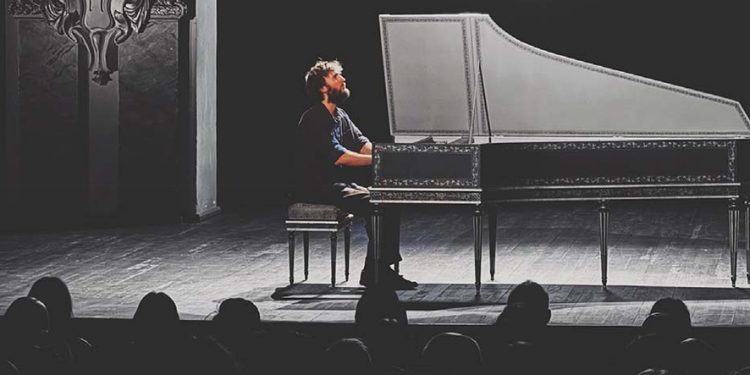The 2024 Tbilisi Baroque Festival unfolded a unique moment in musical history on November 9, as French harpsichordist Jean Rondeau brought his captivating charisma and virtuosity to Rustaveli Theater. In a program dedicated to some of the greatest French Baroque composers—Jean-Philippe Rameau, François Couperin, and Joseph-Nicolas-Pancrace Royer—Rondeau delivered not just a recital, but a rich, multilayered experience. His performance underscored the transformative power of Baroque music, defying any notion that it is only the music of a distant past. Rondeau offered a window into an 18th-century world of opulence, intrigue, and emotional depth, as he showed how the harpsichord, an instrument too often dismissed as merely ornamental, could become a powerful storyteller in his hands.
A Modern-Day Maverick of the Harpsichord: Rondeau’s Revolutionary Touch
Jean Rondeau has always approached the harpsichord with a unique, almost rebellious style. Known for his fluid interpretations, he brings a natural dynamism to the Baroque that feels as bold as it is respectful of tradition. In Tbilisi, he played with the passion and freedom of a jazz artist, while still delivering on the meticulous precision required by French Baroque composers. Rondeau’s hands, often a blur in motion, traversed the keyboard with a sensitivity that turned each piece into a living, breathing narrative. His inventive use of tempo and phrasing breathed new life into each piece, drawing listeners into an experience that was intensely personal and yet almost sacred in its reverence for history.
Jean-Philippe Rameau’s Suite in A Minor: A Journey through Dance, Drama, and Delight
Rondeau opened with Rameau’s Prelude in A Minor, a stately, intricate work that immediately set a reflective tone. The quiet beauty of this piece, under Rondeau’s delicate touch, seemed to ripple through the theater, drawing the audience into a shared space of contemplative stillness. The Suite in A Minor, following on its heels, showcased the formal yet emotional richness of Baroque dance music.
Each movement was a vignette, evoking the elegance of a distant era. In the Allemande, Rondeau displayed a refined restraint, balancing stately form with expressive nuance. The Courante brought a burst of energy, as Rondeau infused each phrase with a kinetic rhythm that suggested the exuberance of courtly gatherings. Yet it was in the Sarabande that Rondeau’s interpretative genius truly shone; his phrasing captured a haunting melancholy, as if unveiling the hidden sorrows beneath Baroque grandeur.
The centerpiece, Les Trois Mains, known for its dazzling hand-crossing techniques, was a masterclass in technical brilliance, while the Gavotte avec les Doubles built to a climactic flourish, each variation adding layers of complexity that Rondeau dispatched with elegance and ease.
François Couperin’s La Misterieuse and La Tenebreuse: The Soul of the Harpsichord Unveiled
Moving to the works of François Couperin, Rondeau ventured into an even more introspective realm of French Baroque music. Couperin’s compositions are marked by a poetic quality, a tenderness that requires an interpretive sensitivity that few can achieve. Rondeau began with L’Art de toucher le clavecin: Prelude in C Major, drawing out the gentle lyricism of this instructional yet surprisingly intimate piece. His interpretation captured the subtleties of each phrase, making the Prelude feel like a personal reflection rather than an academic exercise.
The emotional depth grew richer with La Misterieuse and La Tenebreuse. Rondeau approached La Misterieuse with a spectral lightness, making each note seem to hover in the air like a whispered secret. With La Tenebreuse, his touch turned darker, reflecting the piece’s pensive quality and drawing the audience deeper into Couperin’s haunting landscape. The Sarabande La Lugubre emerged as a profoundly moving lament, as Rondeau allowed each note to resonate with an air of solemnity and nostalgia. Finally, La Favorite, a Chaconne with a lively yet stately character, brought a balanced close to Couperin’s selection, as Rondeau shifted into a more grounded, rhythmic style, accentuating the harpsichord’s dance-like qualities.
Joseph-Nicolas-Pancrace Royer: The Bold and the Daring of La Sensible and La Marche des Scythes
The final works on the program took the evening to an exhilarating conclusion. Royer’s La Sensible and La Marche des Scythes are challenging compositions, characterized by their boldness and dynamic contrasts. In La Sensible, Rondeau demonstrated his expressive mastery, capturing the fragile beauty and tenderness embedded in Royer’s melodies. His ability to coax subtle emotional shades from the harpsichord gave La Sensible a haunting, almost vulnerable quality.
However, it was La Marche des Scythes that provided the evening’s most electrifying moment. This piece, often celebrated for its martial intensity and rhythmic vigor, allowed Rondeau to unleash the full power of his instrument and his technique. Each percussive passage, each thunderous chord, resonated through the theatre like a drumbeat, commanding the attention of every listener. Rondeau’s fingers flew across the keys with breathtaking speed, his technical control turning this composition into a whirlwind of sound and energy.
Reviving the Baroque: Rondeau’s Performance as a Cultural Bridge
Jean Rondeau’s performance was a true revelation, challenging the common misconceptions of Baroque music as stiff or overly formal. His approach made it clear that these pieces, though composed centuries ago, possess a vibrancy and emotional depth that can speak powerfully to today’s audiences. Through his masterful interpretations, Rondeau transformed Rustaveli Theater into a portal to the past, evoking the spirit of French salons, where music was a vehicle for both personal reflection and communal experience.
This concert at the Tbilisi Baroque Festival was more than an exercise in musical heritage—it was an exploration of the Baroque’s enduring capacity to express universal human emotions. Rondeau’s passionate, almost theatrical presence brought the audience into a shared emotional space, where the harpsichord was no longer a relic, but a vibrant, resonant storyteller.
In an age when classical music is sometimes sidelined, Jean Rondeau’s artistry is a reminder of why these compositions matter and why the Baroque’s expressive language remains relevant, centuries later. His performance was a living argument for the harpsichord’s capacity to communicate timeless beauty, his playing as intricate and enigmatic as the music itself. For those fortunate enough to attend, the concert was a rare, transformative experience—one that lingered long after the final note had faded, leaving the timeless resonance of the French Baroque echoing in Tbilisi’s Rustaveli Theater.
By Ivan Nechaev














